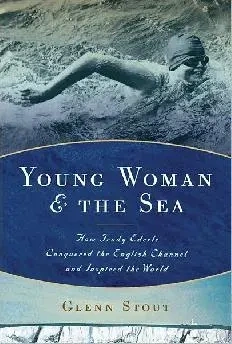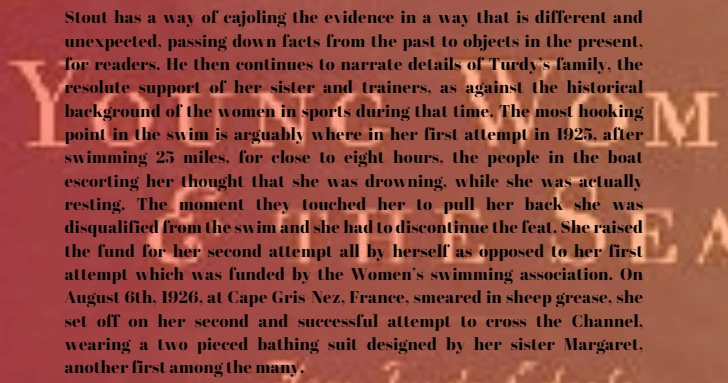BOOK REVIEW- CINEMAHOLICS-YOUNG WOMAN AND THE SEA

‘Young Woman and the Sea; How Trudy Elderle Conquered The English Channel and Inspired the Word’, a 2022 book on the exhilarating story of a woman swimmer’s conquest not just of the ocean but also of the adversities of her times, is all set to come to life on the silver screen on May 31st, on the eve of the Paris Olympics. Just like every other gripping tale destined for the screen, the most asked question surrounding the upcoming movie is whether it is based on a true story. Let us delve into it.
Is Young Woman and the Sea (2024) Based on a True Story?
Yes, the film will showcase the true story of the swimming pioneer, Trudy Elderle, and a pursuit of a goal no one believed was possible.
Glenn Stout’s masterful research combined with Jeff Nathanson’s screenplay, under Joaching Ronning’s visionary direction, Trudy’s relentless and groundbreaking tale of how a girl changed the world, is starred by, Daisy Ridley, best known for her role in Star Wars as Rey, Tilda Cobham-Hervey, Stephen Graham, Kim Bodnia, Christopher Eccleston and Glenn Fleshler. The film is expected to offer to the world of Cinema an uncompromised work ofrealism, of a hearing impaired woman’s daring journey through the treacherous waters, traversing the wild waves of the Channel, particularly after being disappointed by the bronze medal at the Olympics and then failing at the initial attempt of crossing the channel.
Born in 1905, when Turdy Elderle swam to become the first woman to cross the English Channel in 1926 , a 21 mile trek from France to England, she shattered long standing gender norms and made history with her unparalleled determination. The book begins with the tragic sinking of the General Slocum, New York's largest wheel driven passenger steamship, catching fire, resulting in drowning of men, women and children, particularly because the morals of the time restricted women from swimming.
Stout has a way of cajoling the evidence in a way that is different and unexpected, passing down facts from the past to objects in the present, for readers. He then continues to narrate details of Turdy’s family, the resolute support of her sister and trainers, as against the historical background of the women in sports during that time. The most hooking point in the swim is arguably where in her first attempt in 1925, after swimming 25 miles, for close to eight hours, the people in the boat escorting her thought that she was drowning, while she was actually resting. The moment they touched her to pull her back she was disqualified from the swim and she had to discontinue the feat. She raised the fund for her second attempt all by herself as opposed to her first attempt which was funded by the Women’s swimming association. On August 6th, 1926, at Cape Gris-Nez, France, smeared in sheep grease, she set off on her second and successful attempt to cross the Channel, wearing a two pierced bathing suit designed by her sister Margaret, another first among the many.
What seems to be equally eventful than the swim was her rise to fame and a sudden downfall due to her hearing impairment that worsened after the Channel swim. She disappeared from the public eye after injuring her back from a fall in 1933. This was after playing herself, as the swimming instructor in the movie SwimGirl directed by Clarence G Badger, making a 10 minute movie about herself, selling her story to two newspapers, and touring a Vaudeville act.
The most crucial contribution to this body of work would be definitely from Daisy Ridley, a Disney regular, who according to Ronning had to challenge herself on a daily basis, swimming in 60-degree water until her lips turned blue. To uphold the plausibility of the original event and do justice to Turdy’s ordeal, Ronning had chosen not to use blue screens and computer generated images. Director of Photography Oscar Faura said that the water-work presented challenges both technically and in terms of lighting, a challenge that drew him to the project. He states in an interview that, opting for Sony Venice, enabled them to shoot anamorphic and attain the required resolution, which proved to be an ideal match for the film, emphasizing that, when shooting in a boat out at sea, the speed of the tool, providing control over all the neutral density filters, was very crucial to him.
What makes this a true- story that cannot be ‘not’ told, is the larger than life reason why Trudy chose to swim the channel, especially at a time when she did not enjoy the privileges that women have today. Even though Trudy wanted to prove to those who believed a woman could not swim the Channel, that a woman could, Stout strongly opines that it was not a feminist cause. She swam simply because she had nothing left to achieve, but the unachievable. The only way for Trudy to prove everyone was wrong was to try again and succeed. He calls it a ‘challenge’ to her own imagination, a divide which when crossed became the ultimate milestone of a woman’s - and a man’s endurance. Filmed mostly in Kavarna City Bulgaria, the movie is produced by Jerry Bruckheimer Films, Paramount and Disney.

Like this project
Posted May 9, 2024
This was part of an assignment from Cinemaholics to write a review of a book, soon to be a movie.
Likes
0
Views
18





